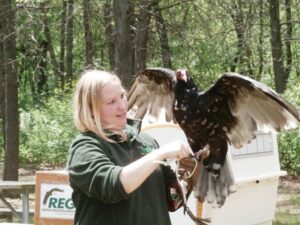Educational fun highlighted at Birdfest
By Marianne Mueller
Reporter
ROCKTON – Hundreds of visitors hailing from as far away as Milwaukee, Chicago, Dubuque plus local people went on a two day educational adventure at Sand Bluff Bird Observatory in Colored Sands Forest Preserve. Behind all of the excitement was a chance to learn about bird’s natural habitats, bird banding, and habits of different species at Birdfest.
“Most banders only band in the forest,” said co-organizer, Lynda Johnson. These sands provide the perfect grassland for sparrows nesting. “We catch so many birds to be banded.
“The reason we are able to catch this number is the location of the river bottom woods by the Sugar River. There are over 350,000 small perching birds and over 4,000 hawks. The only bald eagle that was caught was in 2012. People worry that it may hurt the birds when caught in a net.
“The nets are checked every hour on a regular basis. Rigorous training is provided for removing birds from the net. The net is brought back to have the bird processed, banded and ready to be released.
“The overall procedure is very scientific. In the spring and fall we are studying migrating birds. Bird banding only happens during migration weekends. More birds are caught if it is cold or raining.”
Catering to young ones, a ‘Kids Corner’ offered face painting and a cool learning activity involving looking inside of owl pellets.
Indoors organizer, Lee Johnson showed a variety of birds, giving a background and backstory on each. Holding an oven bird Johnson informed, “This type of bird is one of the most common birds that there is in a dense forest. Sometimes it says, “Teacher, teacher, teacher. When I was six years old we saw American Goldfinches which were the most common bird one can catch.
“More recently one day we caught 850 in an hour and a half. Four people were banding and recruiting. We did not make it in an hour. Johnson explained what the shoulder patch means on a Goldfinch. “
Johnson talked about the natural progression of birds. “They lay eggs, which are incubated, hatched and in 14 days are ready.” Johnson held up a Fuzzy Natal Down. He described the bird’s markings, and feathers that determine the gender.
Johnson urged everyone to be mindful of electing people in various positions who care about preserving the bird’s natural habitat, join a conservation group and to understand the value of nature.
At the end of Mr. Johnson’s presentations, young volunteers were instructed before letting birds go free.
Johnson gave a timeline of each season that birds migrate in. “Birds do not have hair, they have feathers,” Johnson alerted.
Wildlife hikes allowed Birdfest guests to take a journey full of eye catching sites. Along pathways visitors saw bird banding nets amidst fully picturesque scenery.
Abbie Krumrie and Erin Toohey of The Raptor Education group- REGI gave talks on raptors, owls, and vultures and diets of certain species. Fun facts covered that owls take 40 minute naps. They eat small rodents. Birds eat bugs or crickets. Eagles eat fish.
Vultures are very social creatures and can live with crows or ravens. REGI featured a Peregrine Falcon, a Great Horned owl named Fonzie, a smaller rescued barred owl, and Benjie, an American kestrel.
Educational programs on “Taking Aim at lead poisoning in the sacred bald eagle and another on climate change- a natural disaster?
A silent auction, artwork exhibits, and a chance to enjoy food added to a pure family oriented event. Wild Birds Unlimited and specialty birdhouses made out of wood created by Denny Friday. “I use recycled wood from barns that is over 100 years old to save it from going to the landfill, “shared Friday. I like to create something different each year.
This year marks the 49th year of Birdfest. Next year organizers are planning a 50th anniversary celebration. Birdfest originated under the leadership of Lee Johnson in 1967 who continues brining his passion and knowledge to people everywhere.




